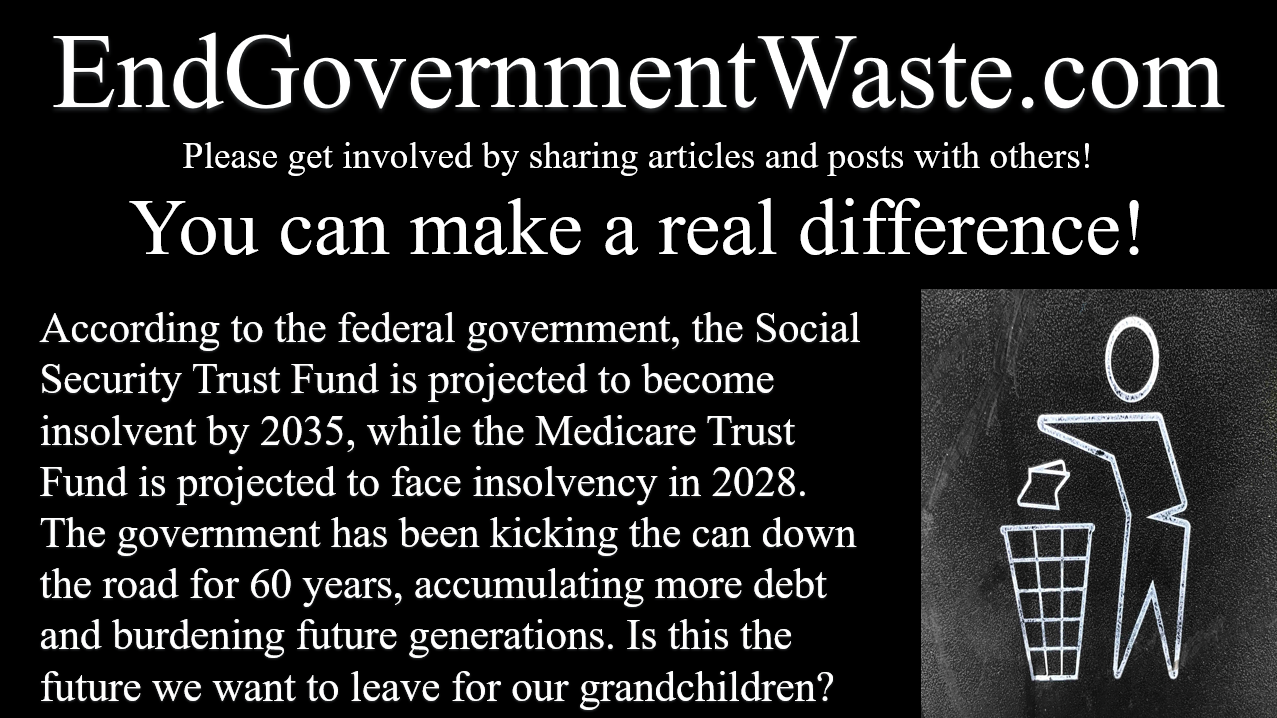



As of June 2023, the national debt and unfunded liabilities represent approximately 339% of GDP, whereas in 1930, they accounted for only 16% of GDP. Federal Reserve Chair Jerome Powell has expressed great concern, stating, “we are on an unsustainable fiscal path” and “better to deal with it sooner rather than later.”
According to the federal government, the Social Security Trust Fund is projected to become insolvent by 2035, while the Medicare Trust Fund is projected to face insolvency in 2028. The government has been kicking the can down the road for 60 years, accumulating more debt and burdening future generations. Is this the future we want to leave for our grandchildren?
More information...
As of June 2023, the US GDP is approximately $26.5 trillion, the national debt stands at approximately $32 trillion, and the unfunded liabilities for Social Security and Medicare amount to approximately $58 trillion, as reported by www.USDebtClock.org. Consequently, the national debt and unfunded liabilities represent approximately 339% of GDP. In 1930, the debt and unfunded liabilities accounted for approximately 16% of GDP. According to the federal government, the Social Security Trust Fund is projected to become insolvent by 2035, while the Medicare Trust Fund is projected to face insolvency in 2028. The government has been kicking the can down the road for 60 years, accumulating more debt and burdening future generations. Is this the future we want to leave for our grandchildren?
According to Federal Reserve Chair Jerome Powell comments from February 2023: “I would say that we're on an unsustainable fiscal path, at the federal government level. That has been the case for some time and it's something we will have to deal with. And better to deal with it sooner rather than later.”[1]
Below are a few key points from the Congressional Budget Office’s 2022 report “The Economic Effects of Waiting to Stabilize Federal Debt”:
- “The longer action is delayed, the larger the policy changes needed to stabilize debt.”
- “As a percentage of gross domestic product (GDP), federal debt held by the public is thus projected to climb from 102 percent at the end of 2021 to 202 percent in 2051. A perpetually rising debt-to-GDP ratio is unsustainable over the long term because financing deficits and servicing the debt would consume an ever-growing proportion of the nation’s income.”
- “Policymakers could restrain the growth of spending, raise revenues, or pursue some combination of those two approaches.”
- “Waiting to put fiscal policy on a sustainable course and allowing federal debt to continue to climb would have several effects on the economy. As federal borrowing increased, the amount of funds available for private investment would decline (a phenomenon known as crowding out), and interest costs would increase. Perpetually rising debt would also increase the likelihood of a fiscal crisis and pose other risks to the U.S. economy.”
- “Regardless of when the process was begun, stabilizing federal debt as a percentage of GDP would require that income tax receipts or benefit payments change substantially from their currently projected path.”
- “Cut spending for certain government benefit programs—mostly for Social Security, Medicare, and Medicaid.”
- “The longer policymakers waited to implement a policy change, the more debt would grow in relation to GDP, and the greater the policy changes needed to stabilize it would be.”
- “The negative effects of delaying the implementation of policy changes on people’s consumption and labor supply would be disproportionately borne by younger people and lower-income people.”[2]
And below are more comments from Congressional Budget Office’s 2023 report “The Budget and Economic Outlook: 2023 to 2033”:
- “Debt held by the public is projected to rise in relation to the size of the economy each year, reaching 118 percent of GDP by 2033—which would be the highest level ever recorded. Debt would continue to grow beyond 2033 if current laws generally remained unchanged.”
- Per the CBO, federal debt held by the public as a percent of GDP has been 1910 3.7%, World War I, 1920 27.3%, 1930 16.3%, The Great Depression, 1940 43.6%, World War II, 1950 78.6%, 1960 44.3%, 1970 27.1%, 1980 25.5%, 1990 40.9%, 2000 33.7%, 2010 60.6%, 2020 99.8%, 2022 97%, and they project (if current laws generally remained unchanged.) 2030 109.9%, 2040 140.5%, and 2050 180.6%. During WW1, the great depression, and WW2, the debt spiked but was then paid down. [3]
Per the "THE 2022 ANNUAL REPORT OF THE BOARD OF TRUSTEES OF THE FEDERAL OLD-AGE AND SURVIVORS INSURANCE AND FEDERAL DISABILITY INSURANCE TRUST FUNDS" (https://www.ssa.gov/oact/TR/2022/tr2022.pdf) released 6-2-22:
- “Under the Trustees’ intermediate assumptions, OASDI cost is projected to exceed total income in 2022, and the dollar level of the hypothetical combined trust fund reserves declines until reserves become depleted in 2035.”
- “The combined reserves are projected to decrease from $2,852 billion at the beginning of 2022 to $1,251 billion at the end of 2031, the last year of the short-range period.”
- “The open-group unfunded obligation for OASDI is $20.4 trillion in present value over the 75-year projection period through 2096 and is $0.6 trillion more than the measured level of $19.8 trillion over the 75-year projection period through 2095 in last year’s report.”
- “To illustrate the magnitude of the 75-year actuarial deficit, consider that for the combined OASI and DI Trust Funds to remain fully solvent throughout the 75-year projection period ending in 2096: (1) revenue would have to increase by an amount equivalent to an immediate and permanent payroll tax rate increase of 3.24 percentage points1 to 15.64 percent beginning in January 2022; (2) scheduled benefits would have to be reduced by an amount equivalent to an immediate and permanent reduction of 20.3 percent applied to all current and future beneficiaries effective in January 2022, or 24.1 percent if the reductions were applied only to those who become initially eligible for benefits in 2022 or later; or (3) some combination of these approaches would have to be adopted.”
- “If substantial actions are deferred for several years, the changes necessary to maintain Social Security solvency would be concentrated on fewer years and fewer generations. Significantly larger changes would be necessary if action is deferred until the combined trust fund reserves become depleted in 2035. For example, maintaining 75-year solvency through 2096 with changes that begin in 2035 would require: (1) an increase in revenue by an amount equivalent to a permanent 4.07 percentage point payroll tax rate increase to 16.47 percent starting in 2035, (2) a reduction in scheduled benefits by an amount equivalent to a permanent 24.9 percent reduction in all benefits starting in 2035, or (3) some combination of these approaches.”
- “Under the intermediate assumptions, the projected hypothetical combined OASI and DI Trust Fund asset reserves become depleted and unable to pay scheduled benefits in full on a timely basis in 2035. At the time of depletion of these combined reserves, continuing income to the combined trust funds would be sufficient to pay 80 percent of scheduled benefits. The OASI Trust Fund reserves are projected to become depleted in 2034, at which time OASI income would be sufficient to pay 77 percent of OASI scheduled benefits. DI Trust Fund asset reserves are not projected to become depleted during the 75-year period ending in 2096.
- Lawmakers have a broad continuum of policy options that would close or reduce Social Security's long-term financing shortfall. Cost estimates for many such policy options are available at www.ssa.gov/OACT/solvency/provisions/. The Trustees recommend that lawmakers address the projected trust fund shortfalls in a timely way in order to phase in necessary changes gradually and give workers and beneficiaries time to adjust to them. Implementing changes sooner rather than later would allow more generations to share in the needed revenue increases or reductions in scheduled benefits. Social Security will play a critical role in the lives of 66 million beneficiaries and 182 million covered workers and their families during 2022. With informed discussion, creative thinking, and timely legislative action, Social Security can continue to protect future generations.” [4]
Per the "2022 ANNUAL REPORT OF THE BOARDS OF TRUSTEES OF THE FEDERAL HOSPITAL INSURANCE AND FEDERAL SUPPLEMENTARY MEDICAL INSURANCE TRUST FUNDS" (https://www.cms.gov/files/document/2022-medicare-trustees-report.pdf) released 6-2-22:
- “Current-law projections indicate that Medicare still faces a substantial financial shortfall that will need to be addressed with further legislation. Such legislation should be enacted sooner rather than later to minimize the impact on beneficiaries, providers, and taxpayers.”
- “The expenditure projections reflect the cost-reduction provisions required under current law but not the payment reductions and/or delays that would result from the HI trust fund depletion. In the year of asset depletion, which is projected to be 2028 in this report, HI revenues are projected to cover 90 percent of incurred program costs.”
- “The financial projections in this report indicate a need for substantial changes to address Medicare’s financial challenges. The sooner solutions are enacted, the more flexible and gradual they can be. The early introduction of reforms increases the time available for affected individuals and organizations—including health care providers, beneficiaries, and taxpayers—to adjust their expectations and behavior. The Trustees recommend that Congress and the executive branch work closely together with a sense of urgency to address these challenges.”
- “With one exception, the projections are based on the current-law provisions of the Social Security Act. The one exception is that the Part A projections disregard payment reductions that would result from the projected depletion of the Medicare HI trust fund. Under current law, payments would be reduced to levels that could be covered by incoming tax and premium revenues when the HI trust fund was depleted.”
- “If assets were depleted, Medicare could pay health plans and providers of Part A services only to the extent allowed by ongoing tax revenues—and these revenues would be inadequate to fully cover costs. Beneficiary access to health care services could rapidly be curtailed.”
- Assets at the end of fiscal year 2021 were 325.7B [5]
[1]https://www.bloomberg.com/news/videos/2023-02-07/powell-the-us-fiscal-path-is-unsustainable-video From February 7th, 2023.
[2]https://www.cbo.gov/publication/57867#:~:text=A%20perpetually%20rising%20debt-to-GDP%20ratio%20is%20unsustainable%20over,a%20percentage%20of%20GDP%20from%20continuing%20to%20climb. “The Economic Effects of Waiting to Stabilize Federal Debt”, released April 28, 2022.
[3]https://www.cbo.gov/publication/58848 “The Budget and Economic Outlook: 2023 to 2033”, released February 15, 2023.
[4] https://www.cms.gov/files/document/2022-medicare-trustees-report.pdf “2022 ANNUAL REPORT OF THE BOARDS OF TRUSTEES OF THE FEDERAL HOSPITAL INSURANCE AND FEDERAL SUPPLEMENTARY MEDICAL INSURANCE TRUST FUNDS”, released June 2, 2022.
[5] https://www.cms.gov/files/document/2022-medicare-trustees-report.pdf “2022 ANNUAL REPORT OF THE BOARDS OF TRUSTEES OF THE FEDERAL HOSPITAL INSURANCE AND FEDERAL SUPPLEMENTARY MEDICAL INSURANCE TRUST FUNDS”, released June 2, 2022.
